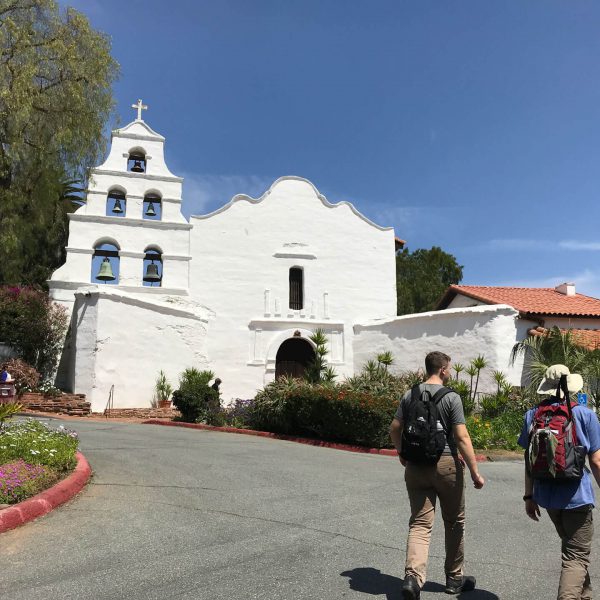SAN DIEGO — A group of pre-seminarians recently put the “journey” in “vocational journey.”
Traveling from their homes in Green Bay, Wisconsin, and led by their diocese’s vocation director, Father Daniel Schuster, nine young men ages 15 to 18 embarked on a pilgrimage that took them to 17 of California’s 21 historic missions.
Father Schuster, who was assisted as chaperone by the grandfather of one of the participants, said the pilgrimage was intended to help young men who had already expressed an openness to the priestly vocation to take “that extra step … literally” on the path of discernment.
The April 2-7 pilgrimage began in San Diego, home to the oldest of the missions, and would ultimately take them as far north as Mission San Francisco de Asís in the Bay Area.
“It seemed like a once-in-a-lifetime experience,” said Nathan Budde, 18, explaining his decision to attend. “I needed some adventure in my life and I enjoy praying.”
Still uncertain of where God might be calling him, 18-year-old Jacob Zepp said that he is “always searching for His will.” It was that search that inspired him to take part in the discernment pilgrimage.
Through his participation, he said, “I hope to better be able to find the will of God, I hope to grow in friendship with Father and my fellow pilgrims, [and] also to learn about the priestly life.”
The idea of retracing the footsteps of St. Junipero Serra, the recently canonized Franciscan friar who personally founded the first nine of the California missions, struck Father Schuster as especially appropriate for high school students discerning God’s call.
He noted that the 18th-century Spanish priest happens to be the patron saint of vocations, as well as “a masculine image of missionary discipleship for these young men to emulate.”
“The distances he covered, the sheer hard work of the missions, is something that this generation needs to know,” Father Schuster said. “They’re going to have to work for the Gospel and take risks.”
On the choice of California as a pilgrimage location, he joked that “the warmer weather didn’t scare us away” and that the young participants appreciated “the culture and the tacos” as well as the Golden State’s rich Catholic history.
Though the pilgrims had a lot to see and much distance to cover during the week, Father Schuster said it was an intentional choice to spend more time in San Diego, where the missions began, than at any other single stop on their journey.
They arrived in San Diego on April 2 and left the diocese on April 4, after paying a visit that morning to Mission San Luis Rey de Francia in Oceanside.
Among the early stops on their pilgrimage was Presidio Park, where Mission San Diego de Alcalá was founded in 1769 before being relocated to its present-day location four years later.
While in San Diego, Father Schuster said, the pilgrims slept for two nights on the floor of the church hall of Immaculate Conception Parish in Old Town San Diego, in an effort to share in some small way in the simplicity of the early missionaries.
They also walked about 7.5 miles from Old Town to Mission San Diego to commemorate the mission’s relocation. Along the way, they prayed the rosary and reflected on the role the Holy Spirit played in helping the friars select locations for the missions, as well as the guidance that the Spirit continues to offer in their own lives.
Father Schuster said the pilgrims reacted with “a bit of awe” upon their arrival at California’s first mission. For Zepp, the visit was “a very prayerful experience,” and Budde described it as a “very peaceful” place.
Father Schuster said the pilgrims’ itinerant existence while on pilgrimage led to several experiences of divine providence.
For instance, at Minneapolis-St. Paul International Airport, where they gathered for Morning Prayer before their flight to San Diego, a stranger who had heard what they were doing liked the idea so much that he gave them a $200 donation to help offset expenses.
A visit to the Diocese of San Diego’s St. Francis de Sales Center for Priests and Priestly Formation, which included time for prayer and fellowship with the diocese’s seminarians, was a late addition to the schedule, Father Schuster said, and “kind of came together at the last minute.”
For Zepp, that ended up being one of the highlights of his time in San Diego.
At another point, it appeared that the group would be unable to celebrate Mass in Serra Chapel at Mission San Juan Capistrano. (The chapel is the only existing building in which Junipero Serra is known to have celebrated Mass.) But on the evening before they were set to arrive, Father Schuster received a phone call informing him that the necessary arrangements had been made.
Whether the young men ultimately discern that they are called to the priesthood or discover that their vocations are to married, single or consecrated life, Father Schuster said he hopes the pilgrims will be forever changed by their experience during the week.
“I just hope that they never go back to living only for themselves,” he said, “but” — inspired by the example of St. Junipero Serra — “will have a missionary heart, a missionary spirit.”
Father Mike Sinor, pastor of Immaculate Conception Parish in San Diego, where the pilgrims spent their first two nights, believes the discernment pilgrimage was a blessing, not only for the pilgrims, but also for the many people they encountered along the way.
“It’s not only what happens to them,” he said. “It’s what happens to other people, in terms of providing hospitality and welcoming them, welcoming the stranger in the name of Christ.”
Father Sinor referenced the story of the unexpected donation the group had received at the airport, as well as the opportunity he had received to host them at his parish, as examples of how their pilgrimage “brings out the goodness of other people.”





